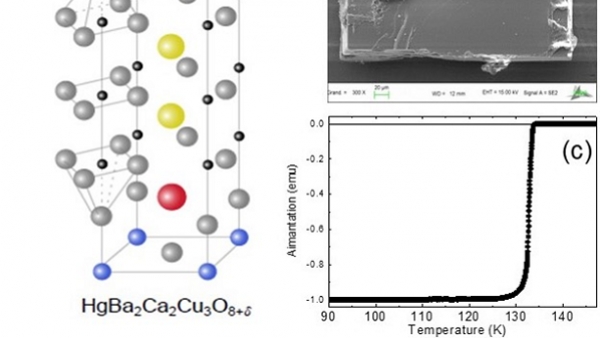A FIRST STEP TOWARDS UNDERSTANDING HIGH-TEMPERATURE SUPERCONDUCTIVITY IN COPPER OXIDES
By studying the phase diagram of copper oxide HgBa2Ca2Cu3O8 + δ, researchers have demonstrated the existence of a microscopic link between the superconducting state and the charge redistribution in the crystal (charge order), which becomes generalized to all superconducting copper oxides.
Superconductors carry electric current without dissipating energy and can not be penetrated by a magnetic field. This results in many applications, such as the transport of electricity without resistance and the levitation of mobiles (trains, surfing). Only superconductivity occurs at very low temperatures. Lead is superconducting below 7 K (-266 ° C) and magnesium diboride (MgB2) below 40 K (-233 ° C). In contrast, the superconducting transition temperature of cuprate HgBa2Ca2Cu3O8 + δ can reach 133 K (-140 ° C) (Figure 1c). Understanding the mechanism at the origin of superconductivity in copper oxides called cuprates is therefore a major challenge to hope to develop superconductors at terrestrial temperatures.
Researchers from the Quantum Materials and Phenomena Laboratory (MPQ, CNRS / Paris Diderot Univ), in collaboration with the Laboratory of Solid Physics (LPS, CNRS / Paris-South University) and the National Laboratory of Strong Magnetic Fields (LNCMI, CNRS), by studying the inelastic scattering of light on the charges (electron Raman effect), to distinguish the spectroscopic signals of the superconducting and charge orders within the pseudogap phase in the cuprate HgBa2Ca2Cu3O8 + δ.
For the first time, the energy scales associated with the superconducting and charge orders could be detected simultaneously thanks to an experimental trick which consisted of minimizing the influence of the pseudogap phase which, otherwise, would have masked their observation. The researchers were able to track the energy scales characteristic of the superconducting and charge order over a large portion of the phase diagram, by controlling the number of charge carriers in the crystals. They showed that these energies are intimately linked: they have almost the same values and follow the same evolution as a function of the number of charge carriers (Figure 2b). This suggests that the superconducting and charge order have the same microscopic origin. The energy scale of the pseudogap also has the same evolution in doping even if its energy is higher. This reinforces the hypothesis that the superconducting, charge and pseudogap phases are intimately connected.
To achieve this result, the researchers worked on cuprate chemical composition: HgBa2Ca2Cu3O8 + δ, whose structure is shown in Figure 2a. It could be synthesized in the form of small crystals (Figure 1b) several hundred microns apart by two researchers from the Department of Condensed State Physics (SPEC, CEA / CNRS). Their extremely clean and smooth surfaces allow them to be explored optically.
The phase diagram of cuprates reveals that the mechanism at the origin of superconductivity is different from that of traditional metals, or their alloys such as lead or magnesium diboride. In fact, by increasing the number of charge carriers carrying the current in a cuprate, its electronic ground state is profoundly modified: from an antiferromagnetic insulator (green zone), it is transformed into a superconducting metal (pinkish zone) (FIG. 2a).
For a concentration of carriers corresponding to a doping of 12% (doping ensured by the addition of oxygen atoms in the planes of mercury atoms see Figure 1a), the superconducting order (in pink in Figure 2a ) coexists with a charge order (in pastel blue) at low temperature, an order characterized by a redistribution of electron charges, different from that usually expected, which follows the arrangement of the atoms of the crystal. These two orders develop within a third so-called pseudogap phase, still poorly understood. To study the superconducting order in this entanglement of states, it is necessary to identify the individual properties of each order and the type of interaction that it develops with the others, and thus to identify the cooperations or competitions (for example, the order does charging increase or decrease superconductivity?). For this purpose, it is necessary to develop effective experimental techniques such as neutron scattering spectroscopies, light (Raman, infra-red, X-ray) or nuclear magnetic resonance. On the theoretical side, it is necessary to use all the power of the digital to implement new theoretical approaches such as cDMFT (cluster Dynamcis Mean field theory).
These works open up a new perspective for understanding the phase diagram of cuprates. The supracondu orders
Latest from Redaction Web 1
- اعلان عن تنضيم دورة لإجراء المسـابقـات و الامتحانات والفحوص المهنيـة - دورة 12 -13 ديسمبر 2025
- Annonce du service de paie
- Important annoncement
- الملتقى الوطني في طبعته 26 للتاريخ و الاثار ايام 12، 13، 14 مي 2023
- La Roumanie annonce l'offre de 40 bourses destinées aux étudiants étrangers au titre de l'année 2023-2024.





